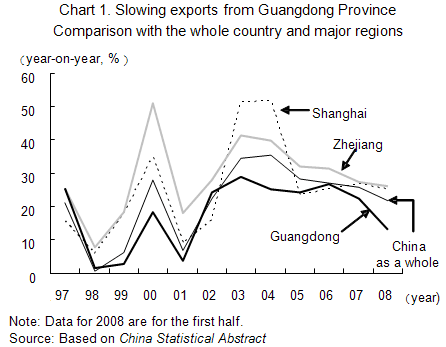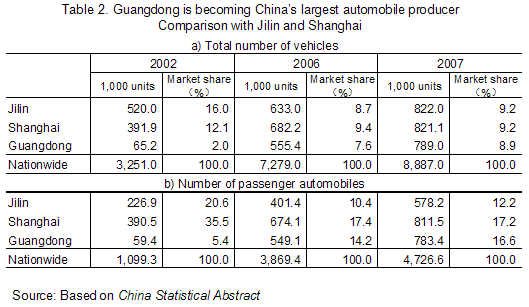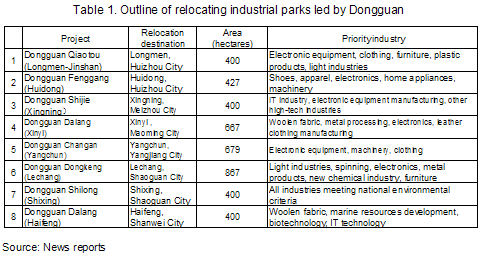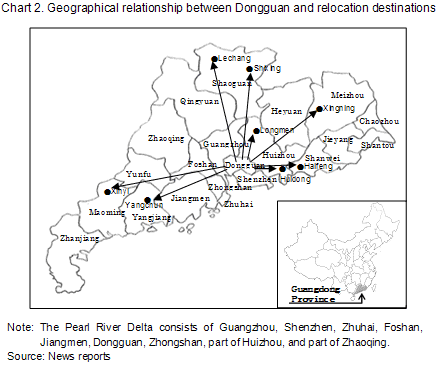Guangdong Province, one of the world's major manufacturing centers, has achieved the highest growth in China since the 1980s by riding the wave of door opening and reform. However, exports from Guangdong are losing steam and many companies, especially those in labor-intensive industries, have fallen into a slump since the start of 2008 due to worsening internal and external circumstances that include increasing costs and the slowing world economy. Aiming for industrial upgrading without hollowing out, the Guangdong government is promoting the relocation of declining industries to less-developed regions in the province to make room for the development of new ones. Thanks to this policy, the leading manufacturing sector is shifting from labor-intensive to heavy industries, particularly the automotive industry.
Slumping exports centered on labor-intensive products
Guangdong has achieved remarkable economic development driven by exports of labor-intensive products mainly from the Pearl River Delta. However, Guangdong's export growth rate (measured in dollar terms) dropped to 13.0% year-on-year in the first half of this year from 26.5% in the first half of 2007, reflecting the deteriorating external environment caused by the U.S. subprime mortgage crisis, the appreciation of the renminbi, downward revisions of export refund tax rates, rising wages, and higher costs due to soaring prices of raw materials. The decline in growth rate is not only larger than that of the entire country, but also of Shanghai and Zhejiang Province, which compete with Guangdong in overseas market (chart 1)

An analysis of products exported from Guangdong reveals that sluggish exports of labor-intensive products, including clothing (down 31.3% year on year) and plastic products (falling 4.5%), stood out in the first half of this year, causing small- to medium-sized companies in these industries to go bankrupt one after another. On the other hand, the exports of machinery (up 19.0%) and high-tech products (rising 19.1%) remained strong and propped up total exports.
"Emptying the cage for new birds" strategy
Aiming for industrial upgrading without the hollowing-out of industry, Guangdong Province is promoting the "emptying the cage for new birds" strategy in which the province relocates declining industries away from the advanced Pearl River Delta region to less-developed peripheral areas while inviting new industries to the region. The strategy is expected to produce the dual effect of releasing land, human and other resources for higher value-added industries in the advanced area while creating employment opportunities in the developing areas. This in turn should help narrow the economic gaps among regions and upgrade the industrial structure of the province as a whole. Many industries have been transferred in stages from advanced countries to developing countries in Asia through direct investment since the end of World War II, a development process called the "flying geese pattern." The "emptying the cage for new birds" strategy promoted by Guangdong can be interpreted as a "provincial version" of this "flying geese pattern."
To facilitate the transfer of industries, the Guangdong government has hastened the construction of infrastructure, especially roads, to improve access to the areas surrounding the Pearl River Delta. Industrial parks are also being built to accommodate relocation. Throughout the process that includes financing, development, construction, and recruitment of enterprises, the municipal governments from which industries were transferred have taken the lead, and they are rewarded with part of the taxes collected from the enterprises that have moved. By the end of June 2008, the Guangdong government had granted approval for the construction of 26 industrial parks involving cooperation between six Pearl River Delta cities, including Dongguan, and 13 outlying cities located to the east, the west, and in the northern mountainous area (table 1, chart 2).
The Guangdong government is encouraging not only the transfer of declining industries from advanced to less-developed areas, but also that of labor in the opposite direction (referred to as "two-way transfer"). At the same time, it is bolstering its vocational training system to improve the quality of the workforce, and it is reforming the household registration system so that skilled migrant workers who have come to work for a certain period of time can obtain permanent residency easily.
Outlook for industrial advancement
The development of new industries to replace labor-intensive industries is necessary for industrial advancement. The "decisions for accelerating the building of a system of modern industries in Guangdong" that was announced in August, identifies high-value-added services including finance, distribution, and information; and heavy industries including industrial machinery and equipment, automobiles, steel, petrochemicals, and shipbuilding; as promising industries for development.
Among heavy industries, the automotive industry is growing rapidly as Japanese auto makers continue to make inroads. In 1998, Honda acquired a plant from France's Peugeot when it decided to withdraw from the area. Nissan and Toyota built plants in Guangzhou and started production in earnest following China's entry into the WTO. Like Detroit and Toyota City, an auto-related industrial cluster with Guangzhou as its core is taking shape. Auto production in Guangzhou reached 789,000 units (8.9% of national production) in 2007, and is catching up with Jilin Province (822,000 units, 9.2%) and Shanghai (821,000 units, 9.2%). In terms of passenger car production, Guangdong (783,000 units, 16.6%) has overtaken Jilin (578,000 units, 12.2%) and moved into second place behind Shanghai (812,000 units, 17.2%; table 2). The car industry in Guangzhou now mainly serves the domestic Chinese market, but it has the potential to become a large export industry.
Thus the difficulties facing Guangdong's labor-intensive industries should be interpreted as the cost of adjustment resulting from the process of industrial upgrading that is reaching a new stage, rather than as symptoms of industrial hollowing out. Based on this understanding, we should highly regard Guangdong's industrial policy of developing new industries instead of protecting declining ones.





